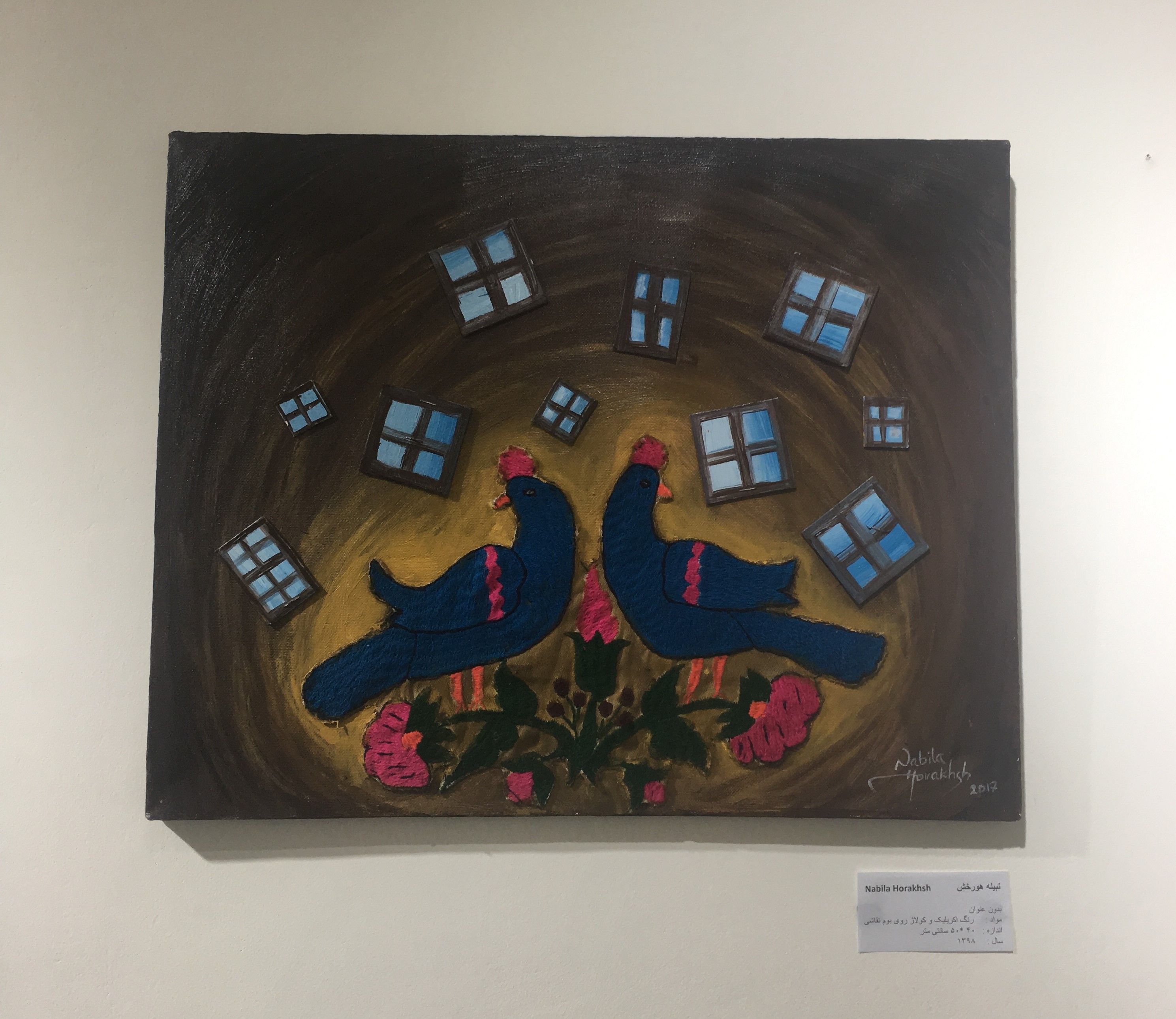/ Looking back at Chahar Chob / Muheb Esmat
Looking back at Chahar Chob
Muheb Esmat
Jul 15, 2021

Pictured: Jahan Ara Rafi, Untitled, 2019. Acrylic on paper.
Chahar Chob, an exhibition of works by artists Shamsia Hassani, Jahan Ara Rafi, and Nabila Horakhsh, was on view at the Afghanistan Photographers Association (APA) gallery in Kabul in the summer of 2019. Organized by Berang Arts, a contemporary art organization founded by Kabul-based artists in 2008.A short text hanging near the entrance to the gallery explained that Chahar Chob (frame/framework) aimed to “emphasize the important role that women artists play in bringing peace and positive change in society.” The exhibition text further elaborated how the three artists, through their works, have sought to be a voice for change.
The show began with two paintings by Shamsia Hassani hanging across from each other. In Untitled (2019), a narrow horizontal acrylic and spray painting on canvas, Hassani depicts her now-signature female figure with long and sharp eyelashes casting a shadow on her closed eyes with no mouth in sight. This numbingly silent figure is framed in a powerful pose; with her body resembling a mountain at the back, she opens her arms wide to embrace the city in front of her. Her dark hair, peeping from underneath her headscarf, flying against the turbulent storm, while the dark blue skies and the bats circling the city contribute to the melancholy evaporating from the painting.

Pictured: Shamsia Hassani, Untiled, 2019. Acrylic and spray on canvas.
Hassani, a graduate of Kabul University, is famously known for her graphic paintings on walls in Kabul and abroad. In her narrative-driven works that stylistically lean towards comics, the recurrent central figure in her work moves swiftly between scenarios and settings, chronicling Afghan women's roles in their contemporary society with the agency provided and restricted to them.
Nabila Horakhsh’s works in the exhibition presented the artist's keen interest in a marriage between traditional and contemporary aesthetic practices. Her Untitled (2018) is a combination of acrylic paint and embroidery on canvas. Two woven birds with pink crowns looking away from each other set gently upon the pink flowers placed at the bottom center of the painting. A combination of a dark brown on the edges and a mustard yellow in the middle makes visible the artist's attempt at illustrating a hallowing depth whirling around the birds. The closed windows hovering above their heads are ambiguous in their representation of inside and outside, resulting in a powerful gesture pointing towards the inescapable realities that women face across both spaces. Horakhsh states that her work seeks to portray the hopes and dreams of Afghan women, whose voices and identities are often missing from the conversation around what is happening but continue to fight for a better future.

Pictured: Nabila Horakhsh, Untitled, 2017. Acrylic and collage on canvas.
Of the three artists, Ari Rafi’s works in the exhibition set apart due to her unique visual vocabulary and tendency to tread the line between abstraction and direct representation masterfully. For example, in Untitled (2017), acrylic on canvas painting, Rafi presents a portrait of a bald figure in a blue blouse facing away from the viewer. Helped by her elongated neck of humiliated flesh, the figure hopelessly rests her head on her right shoulder. Avoiding prevalent cliches around women’s representation in art from and about Afghanistan, Rafi’s distinct interest in the ambiguity of her subjects allows her work to dislodge the viewer from the comfort of their place in the world and recognize and contemplate the neck-breaking weight of being a woman in today’s Afghanistan.

Pictured: Jahan Ara Rafi, Untitled, 2019. Acrylic on paper.
Revisiting this exhibition almost two years later is both heartbreaking and necessary. As the country continues to struggle with a brutal war and the clouds of uncertainty around its future continue to expand, artists such as Hassani, Horakhsh, and Rafi face genuine concerns around their place as Afghan women artists. As the works in the exhibition testified, the realities of being a woman and an artist in Kabul have never been easy. And if the years since the show could attest to anything, it has not gotten any better since. Evident by the male-dominated peace negotiations between the current Afghan government and the Taliban, which has so far been a disastrous ordeal, to say the least, life as an artist and a woman will not get any easier in the future. Unless we take a deeper and critical look at the roots of the inherent inequalities prevalent across all lines of life and ponder together what role women and artists want to have in constructing an inclusive societal “frame” for the future.